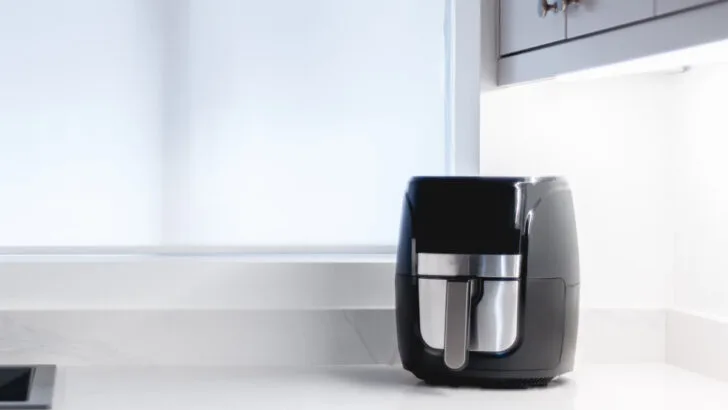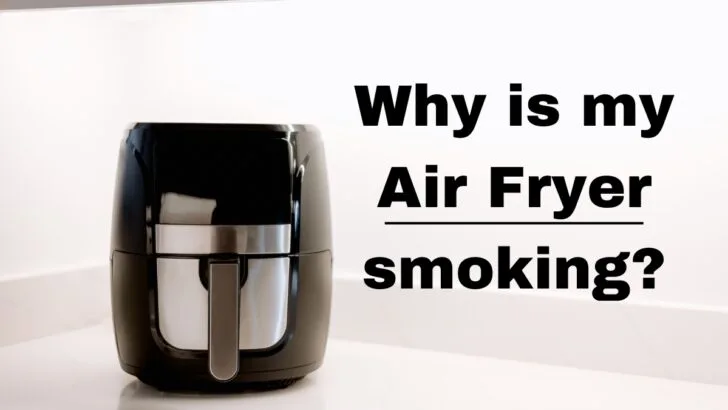Is smoke coming from your air fryer vents or the air fryer itself? Then don’t scratch your heads, as this is an issue that can be resolved.
Your air fryer may be smoking because of too much grease, food accumulation, or because it has to be thoroughly cleaned. To troubleshoot this, unplug your device as soon as you see any smoke and then check it over to identify the source.
However, it is important to know why air fryers periodically emit smoke if you want to keep the air inside your home clean and smoke-free, along with keeping your air fryer working for a longer period. So let’s look at a few typical causes and understand how to reduce air fryer smoke.
Reasons Why Your Air Fryer Is Producing Smoke
Here are the potential causes which make your air fryer produce smoke:

1. Burning Food
There is a significant likelihood that food particles are left in your air fryer, which may cause the smoke. Foods coated in breadcrumbs or batter may have fragments of the coating blown around the kitchen by the air fryer’s superheated air if they are cooked with a loose coating.
These crumbs will eventually rest on the heating element, where they will be burned. These charred pieces can cause a great deal of smoke to be produced. There’s also a chance that the food is elevated to such an extent that it makes contact with the burner.
2. Overflowing Basket
One such cause of air fryer smoke is that the contents of your basket are too crowded. You can’t get enough warm air circulating if your basket is full of food. Because of this, the food will cook sparingly and may even catch on fire resulting in smoke.
If your model cooks at a very high temperature, you might need to reduce the temperature setting to prevent smoke from forming. And as experts suggest, you should only stick to air fryer recipes.
Your food needs to become more familiar with your particular machine or its cooking temps. If the heat is too high and your food is scorching, you should lower the setting. If that’s the case, reduce the temperature setting and increase the cooking time for the meal.
3. Elevated Temperatures
Each air fryer is different. While some feature precise temperature settings ranging from 0°F (-17.77°C) to approximately 500°F (260°C), others have a more basic number-based system.
Nevertheless, most air fryers have elements of both plastic and metal. A constant stream of high temperatures can eventually melt or damage these parts, despite their intended use in an air fryer.
Many items don’t require the highest heat setting when using an air fryer. By choosing a high temperature, users who want to cook their favorite air fryer treats more quickly risk mistakenly creating a smoke-filled appliance.
4. Long Cooking Periods
Did you know that the majority of items that are air-fried can be cooked within 15 minutes?
Owning and operating an air fryer has several advantages, but one of the most notable is the short cooking time. On the other hand, you might need to become more familiar with the correct cooking times for your appliance.
Your food and air fryer may risk being burned if you routinely set cook periods of 30 minutes or more. When the temperature in an air fryer is adjusted to 400 degrees Fahrenheit (around 205 degrees Celsius). For instance, it takes about 15 minutes for a raw steak to cook to be medium done when cooked in the air fryer.
However, keep in mind that the primary purpose of an air fryer is to facilitate rapid cooking. There should always be a situation where you must keep one running for a maximum of half an hour at any particular time. Even after preheating, you shouldn’t let your air fryer run for more than half an hour at a time, and this is especially true when the temperature is set to a high level.
Final Words on Why Your Air Fryer is Producing Smoke
Several factors can cause an air fryer to produce smoke. The accumulation of an excessive amount of grease or oil while cooking is by far the most common cause.
Food fragments that flutter around and stick to the heating coil or compartment are the second typical cause. Other than this, there might be temperature problems, or chances are you’re cooking dishes that take longer.
However, whatever the cause is, make sure you investigate each of the causes that have been outlined in the previous paragraphs and give each of the suggested solutions a shot before giving up.


